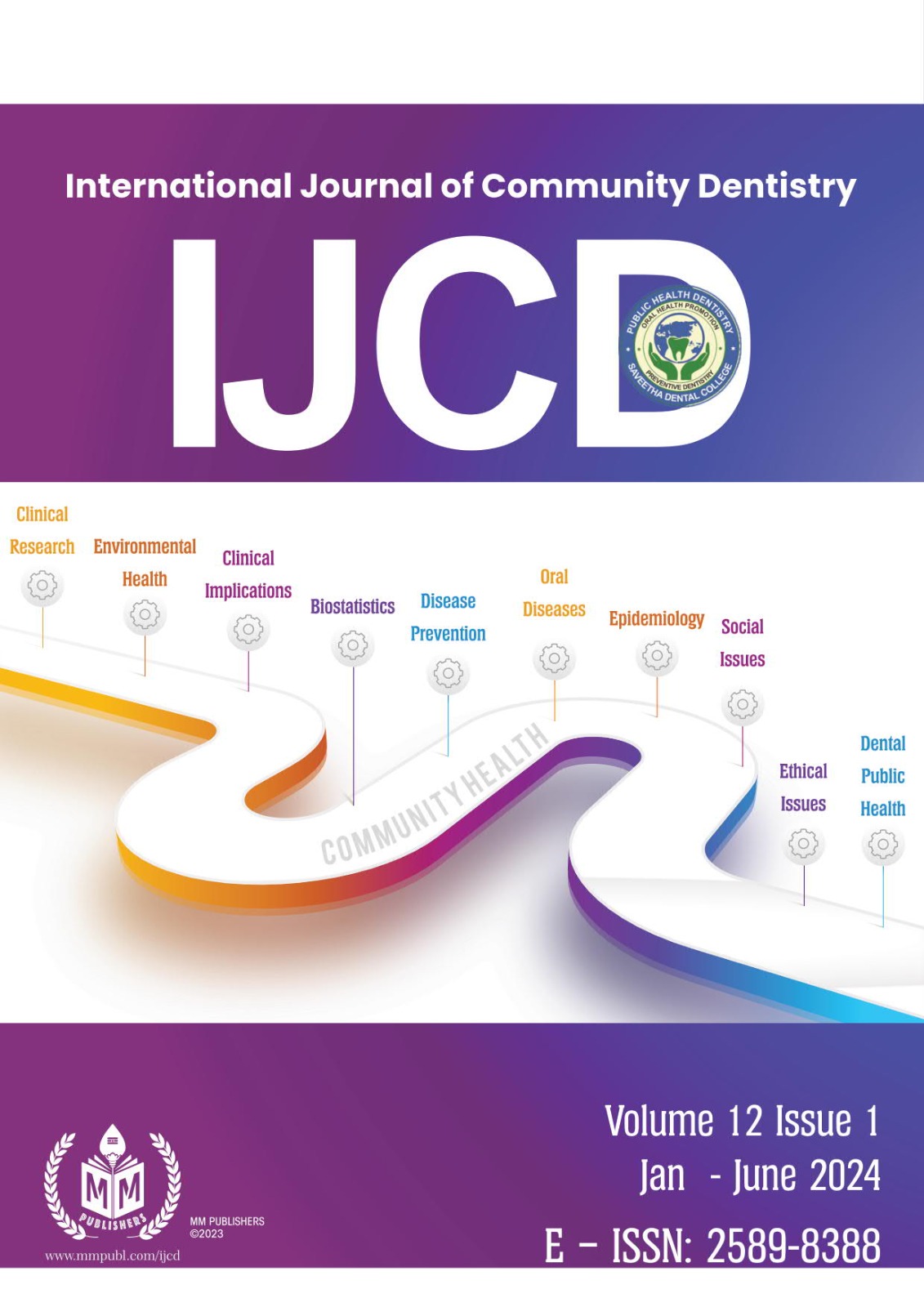Knowledge, Attitude, and Willingness to Treat HIV positive Patients and Practice of Infection Control Measures and Post-exposure prophylaxis amongst dentists in Chengalpattu
DOI:
https://doi.org/10.56501/intjcommunitydent.v12i1.999Keywords:
HIV/AIDS, Infection control, Post exposure prophylaxis, willingness to treat PLWHA, PLWHAAbstract
Objective: To assess the knowledge, attitude, and willingness towards the treatment of HIV-positive patients, Practice of Post-exposure prophylaxis methods, and standard infection control protocol among dentists and dental students in Chengalpattu district, Tamil Nadu, India
Materials and methods : A cross-sectional questionnaire-based study was done using Google Forms. 200 dentists and dental students in the clinical part of the dentistry program (years 4 and 5) in Chengalpattu participated in the study
Results : Amongst the 200 dentists surveyed, 88% say that they are willing to treat HIV-positive patients. Only 21% know the immediate action to be taken in case of direct blood contact with HIV positive patient (i.e.) anti-AIDS drugs such as Zidovudine should be taken. Our interpretation of Practice of infection control methods as per OSHA regulations is that 97.5% of dentists wear gloves to treat or screen all patients, 89.5% dentists use aprons/ gowns as personal protective equipment, 78.5% dentists use goggles to prevent accidental exposure to eyes, 97% dentists wash their hands after handling every patient and 85.5% dentists never bend or recap needles after use.
Conclusion : Dentists need better training on HIV post-exposure prophylaxis methods due to knowledge gaps, impacting their comfort in treating PLWHAs. This study suggests awareness campaigns and training programs to bridge this gap and improve their competence and confidence.
References
Statista [Internet]. [cited 2024 Feb 3]. India: number of people living with HIV 2022. Available from: https://www.statista.com/statistics/1291688/india-number-of-people-living-with-hiv/
Park JC, Choi SH, Kim YT, Kim SJ, Kang HJ, Lee JH, et al. Knowledge and attitudes of Korean dentists towards human immunodeficiency virus/acquired immune deficiency syndrome. J Periodontal Implant Sci. 2011 Feb;41(1):3–9.
Alali FM, Tarakji B, Alqahtani AS, Alqhtani NR, Nabhan AB, Alenzi A, et al. Assessment of Knowledge and Attitude of Dental Students towards HIV and Its Oral Manifestations in Saudi Arabia—A Cross-Sectional Study. Healthcare. 2022 Jul 25;10(8):1379.
Oberoi SS, Sharma N, Mohanty V, Marya C, Rekhi A, Oberoi A. Knowledge and Attitude of Faculty Members Working in Dental Institutions towards the Dental Treatment of Patients with HIV/AIDS. Int Sch Res Not. 2014 Oct 28;2014:429692.
Saleem H, Waly N, Abdelgawad F. Knowledge, Attitude, and Practice (KAP) of post exposure prophylaxis for fifth year dental students at a private Egyptian university: a cross-sectional study. BMC Oral Health. 2023 Mar 24;23(1):167.
Shaghaghian S, Pardis S, Mansoori Z. Knowledge, Attitude and Practice of Dentists towards Prophylaxis after Exposure to Blood and Body Fluids. Int J Occup Environ Med. 2014 Jul 1;5(3):146–54.
Mukherjee S, Bhattacharyya A, Goswami DN, Ghosh S, Samanta A. Knowledge and Practice of Standard Precautions and Awareness Regarding Post-Exposure Prophylaxis for HIV among Interns of a Medical College in West Bengal, India. Oman Med J. 2013 Mar;28(2):141–5.
Patil PB, Sreenivasan V, Goel A. Knowledge of HIV/AIDS and attitude of dental students towards HIV/AIDS patients: A cross-sectional survey. J Educ Ethics Dent. 2011 Jul 1;1(2):59.
Wimardhani YS, Ossa YF, Wardhany II, Maharani DA, Lee C. Indonesian Dental Students’ Attitudes, Knowledge, Preparation, and Willingness to Treat HIV/AIDS Patients. Eur J Dent. 2022 Jan 6;16(4):867–74.
McCarthy GM, Koval JJ, MacDonald JK. Factors associated with refusal to treat HIV-infected patients: the results of a national survey of dentists in Canada. Am J Public Health. 1999 Apr;89(4):541–5.
Abou El Fadl RK, Abdelmoety A, Farahat Z, Hussein MA. Assessing the levels of HIV-related knowledge and attitudes toward HIV-infected patients among undergraduate dental students: a cross-sectional study. HIVAIDS Auckl NZ. 2019 Apr 23;11:83–92.
Kumar S, Mishra G, Gupta VK. Knowledge and Practice of Post Exposure Prophylaxis among BDS Interns. Ann Int Med Dent Res.
Fotedar S, Sharma KR, Sogi GM, Fotedar V, Chauhan A. Knowledge and Attitudes about HIV/AIDS of Students in H.P. Government Dental College and Hospital, Shimla, India. J Dent Educ. 2013 Sep;77(9):1218–24.
Jain A, Pandurangan KK. Knowledge, Attitude, and Practice regarding Hepatitis B & C and HIV/AIDS among Dentists in Chennai, India. PalArchs J Archaeol Egypt Egyptol. 2020 Nov 28;17(7):2128–42.
Mathewos B, Birhan W, Kinfe S, Boru M, Tiruneh G, Addis Z, et al. Assessment of knowledge, attitude and practice towards post exposure prophylaxis for HIV among health care workers in Gondar, North West Ethiopia. BMC Public Health. 2013 May 25;13(1):508.

Downloads
Published
How to Cite
Issue
Section
License
Copyright (c) 2024 Parvathy Premnath, Mathu Sree H, Monish Ananthan S, Maris Manoj Kumar G, Menaka S, Mohamed Arsath H

This work is licensed under a Creative Commons Attribution-NonCommercial 4.0 International License.



